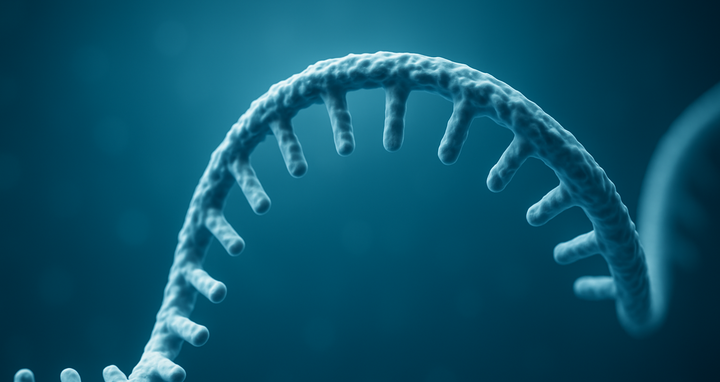How cellular quality control works
All human cells rely on a specific process to maintain quality control: nonsense-mediated mRNA decay (NMD). This mechanism monitors messenger RNAs (mRNAs), which carry the blueprints for protein production. If errors are detected, the faulty transcripts are discarded before they can give rise to incomplete or potentially harmful proteins – molecules that might trigger conditions such as developmental disorders or cancer.
In their new study, the Cologne team led by Professor Niels H. Gehring at the Institute for Genetics, along with Professor Markus Landthaler and Dr. Philipp Mertins from the Max Delbrück Center, used molecular switches to selectively and precisely deactivate UPF1, the key protein that drives the NMD process. This approach made it possible, for the first time, to observe NMD function in human cells with unprecedented precision. The study was published in “Molecular Cell.”
Markus Landthaler, Scientific Group Leader
A key outcome is a comprehensive database that, for the first time, systematically identifies which genes and gene variants are directly affected by NMD. This resource is freely available to researchers worldwide at https://nmdrht.uni-koeln.de and opens new avenues for RNA and genome research.
Not just error protection
“With our new system, we can for the first time observe how quickly and extensively NMD acts in human cells. This shows that NMD is not just a safeguard against errors – it’s also an important regulator of gene activity,” says Gehring.
The researchers found that NMD follows specific rules. When a blueprint for a protein contains a premature stop signal, the cell detects the error and eliminates the faulty transcript. This prevents the production of useless or harmful proteins.
“Thanks to the new system, we’ve identified many previously overlooked RNA variants that are regulated by NMD – including some involved in brain development,” adds Dr. Volker Böhm, first author of the study. “It’s surprising how many variants there are. We will now investigate what drives this diversity. Until now, these variants remained hidden because suitable analytical tools were lacking. Our database will be an important global resource for genomic research.”
“This study powerfully demonstrates how new technologies can reveal fundamental biological mechanisms that are critical to both health and disease,” says Landthaler, also a senior author of the study.
The study was conducted and financed as part of the Collaborative Research Center SFB1678 “Systemic Consequences of Fidelity Changes in mRNA and Protein Biosynthesis” of the German Research Foundation (DFG), with additional support from the Center for Molecular Medicine Cologne (CMMC).
Text: University of Cologne
Further information
University of Cologne press release
Landthaler lab
Profile of Markus Landthaler
Proteomics-Platform, Philipp Mertins
Literature
Volker Böhm et al. (2025): “Rapid UPF1 depletion illuminates the temporal dynamics of the NMD-regulated human transcriptome.” Molecular Cell, DOI: 10.1016/j.molcel.2025.08.015
Contact
Prof. Dr. Niels Gehring
Institute for Genetics
Medicine Cologne (CMMC)
+49 221 470 3873
ngehring@uni-koeln.de
Prof. Dr. Markus Landthaler
Group Leader, RNA-Biology and Posttranscriptional Regulation
Berlin Institute for Medical Systems Biology of the Max Delbrück Center
+49 30 9406-3026
markus.landthaler@mdc-berlin.de
- Max Delbrück Center
Das Max-Delbrück-Centrum für Molekulare Medizin in der Helmholtz-Gemeinschaft legt mit seinen Entdeckungen von heute den Grundstein für die Medizin von morgen. An den Standorten in Berlin-Buch, Berlin-Mitte, Heidelberg und Mannheim arbeiten unsere Forschenden interdisziplinär zusammen, um die Komplexität unterschiedlicher Krankheiten auf Systemebene zu entschlüsseln – von Molekülen und Zellen über Organe bis hin zum gesamten Organismus. In wissenschaftlichen, klinischen und industriellen Partnerschaften sowie in globalen Netzwerken arbeiten wir gemeinsam daran, biologische Erkenntnisse in praxisnahe Anwendungen zu überführen – mit dem Ziel, Frühindikatoren für Krankheiten zu identifizieren, personalisierte Behandlungen zu entwickeln und letztlich Krankheiten vorzubeugen. Das Max Delbrück Center wurde 1992 gegründet und vereint heute eine vielfältige Belegschaft mit rund 1.800 Menschen aus mehr als 70 Ländern. Wir werden zu 90 Prozent durch den Bund und zu 10 Prozent durch das Land Berlin finanziert.







